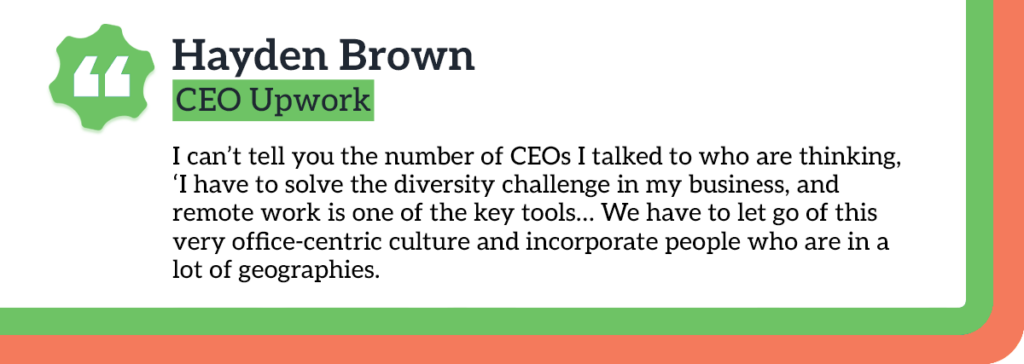Remote first Staffing Strategy: A key to Future Business Success

Did you know the average U.S. employer can save over $11,000 annually on each part-time remote employee and achieve a 21% higher profitability?
With the right remote-first staffing strategies, you, too, can propel your business to new heights.
The phenomenon of remote staffing and online work dates back to the Internet’s infancy. In the early 1990s, when the Internet began to proliferate in mainstream society, connecting users and customers beyond geographic bounds became a reality. Mobile phones, emails, and text messaging were some of the earlier elements of what would eventually become remote-first strategies.
Similarly, companies started experimenting with remote work strategies between traditional office spaces and more relaxed, in-house work environments around that time.
Some of the earliest versions of remote staffing in recent times can be found in call centers and tech support. The idea gained more traction with time, as cell phones made connecting people outside professional settings easier. Notably, the propensity for remote work is not equally distributed across industries. Still, the overarching trend for most industries is a rise in remote work.
Business, IT, and finance sectors experienced the most growth in remote staffing. However, the construction and healthcare sectors saw the most minuscule increase in work from home.
You might be surprised that this trend cannot solely be attributed to the past few years’ global socioeconomic and health challenges and is not transient.
Today, there is a general affinity towards online and other non-traditional work options, with enough evidence suggesting mutual benefits to both the employer and the employee. According to a survey conducted by Owl Labs, 59% of the respondents indicated a willingness to work for an employer who offered a work-from-home option compared to one who did not. Similarly, a study conducted by Mercer suggested a staggering 94% of employers reported a parity of an increase in productivity when employees were allowed to work from home.

Yet, those hesitant to adopt remote first staffing strategies incur significant costs. Businesses could have avoided such costs with a more flexible work environment. For example, rental costs, office equipment, and commute time are all products of a work setting quickly becoming a relic of the past.
It is rather difficult to make predictions about future trends. However, developing communication and connectivity techniques, a greater public preference for a work-life balance, and lessons learned from the past few years will likely create more flexible and innovative work settings. Therefore, remote staffing will likely assume future organizational strategies’ center stage.
If you want to stay ahead of the curve, start considering remote first staffing strategies for your business.
Developing a Remote-First Staffing Strategy
It is an organizational strategy that sets up policies, procedures, and infrastructure to promote and facilitate remote work instead of merely accommodating it or accepting it under extraordinary circumstances.
You can think of it as akin to “mobile-first” in the design world. Mobile-first is where developers and UX designers create digital experiences for phones and tablets. Such a strategy leaves the desktop/laptop experience as a trailing requirement.
Remote-first” prioritizes the remote work experience. It relegates the office—if there is one—to just another place an employee may sit.
When you can’t rely on a building and proximity to bring your team together, teach them the ropes, align them on priorities, and motivate them to produce good work, you’ve got to be intentional about how work will get done.
The following are a few of the key tenets:
- Rules of Engagement: Be clear about the who, what, when, where, and how for each employee, team, project, and goal. While some practices and procedures may differ for a remote-first company, the overarching theme remains the same.
- Access: Provide employees with access to the physical items they need to do their jobs (i.e., laptops and smartphones), tools and data (i.e., Google Drive, email, your CRM), and access to their teammates, managers, and company executives.
- Communication: Most importantly, you’ll need to ensure your employees can easily communicate and stay on the same page. Establishing a single communication channel is helpful so that everyone stays in the loop.
- Time Management: Your team will work from different localities and time zones. Therefore, it is pertinent to establish and communicate clear deadlines for your projects well in advance. This practice will prevent any last-minute hiccups or delays due to time differences among your team.
- Quality Control: Digital workspaces require meticulous reporting and quality assurance mechanisms. You must consider using the right project management and reporting tools to ensure that the quality of the work remains consistent regardless of location.
Benefits of Remote Collaboration
You are probably thinking: Remote staffing sounds good, but what tangible benefits does it bring to my business?
And how does it affect my bottom line?
For brevity, here are a few benefits of remote first staffing that can surely inspire you to take action:
- Cost savings: The most outstanding benefit of this strategy is cost cuts in terms of office, rental, and maintenance. When you have a physical infrastructure, it takes a considerable amount to upkeep, which can dramatically increase your fixed costs. Similarly, a remote-first staffing strategy will allow you to save significantly on equipment, commute, and security. All of that money you can invest elsewhere or pass through to profits.
- Employee satisfaction: Several studies indicate that disregarding exceptions, employees prefer to work with a flexible schedule in remote or hybrid environments. Remote work also allows employees to enjoy a better work-life balance, save commute time, and work at their own pace. With higher employee satisfaction, you can expect more productivity engagement and lower absenteeism and attrition rates.
- Expanded talent pool: With a remote-first staffing strategy, the world truly becomes flat. If you remove the biggest barrier to getting a job in your company (living close enough to get into the office daily), you can hire the right person for each seat in your organization. It doesn’t matter if they are on the other side of the country or halfway around the world. The only thing that matters is that they are the right person for the job.
- Defined performance metrics: An online work environment forces companies to create digital, traceable, measurable performance metrics. When all or most of the work is done remotely, employees will work with digital tools, making tracking, reporting, and measuring performance much easier. Moreover, a digital workspace will standardize company processes and make them easier for everyone to follow, thus ensuring the same quality of work every time.
- Automation and outsourcing opportunities: Greater flexibility in hiring and retaining the workforce also allows for greater opportunities to automate and outsource. When you know your talent potential and limitations, it becomes easier to prioritize tasks and automate or outsource them. The purpose is to reduce organizational inefficiencies and redundancies and ensure that no one works above or below their pay grade. For example, you want your VP of Sales to talk to customers on the phone, but you don’t want her to spend hours on prospect research, googling each person to collect data. You can outsource that to a Virtual Assistant. Similarly, you don’t want your marketing and customer success team to manually email clients daily. Instead, you can Automate such tasks using appropriate automation tools.
- Intensified focus and alignment: In an office setting, everything can change on the whim of a leader. There are just too many external factors to distract you and cause you to lose focus. Whether it is gossip or unwarranted noise, you are bound to get interrupted at regular intervals. It is certainly not the case in a remote work setting. Employees can either work quietly from their home office, go outside to a scenic place for creative inspiration, or hop on a group call in case something needs to be discussed with their colleagues.
- Increased productivity: With everyone running towards the same finish line, productivity increases. Plus, your employees stay focused on work without a water cooler or coffee machine to gather around or other friends to pass on the way to and from the bathroom.
Potential Hazards of a Remote-First Workforce
The benefits of remote collaboration stack up nicely – but there have to be negatives as well – right? Of course, there are. But, they are, by and large, due to a lack of planning. If you don’t take the time to create rules of engagement, ensure that your employees have adequate access, and don’t place communication at the center of everything – you’ll fail.
This is where it is imperative to consult with industry leaders on hiring, managing, and retaining employees for a remote-first strategy. Luckily, We Are Working’s six-step onboarding process offers and ensures only the best talent for your company. We help streamline your business processes, develop SOPs, and establish quality control measures to ensure you are not nerfed by talent limitations, a lack of training, or cultural or linguistic barriers.
Without those key components, just about every benefit above becomes a potential point of failure. What you save on rent is wasted on hiring the wrong people, going in a thousand different directions that don’t lead to a profitable result, missing opportunities to streamline the business, and having a disgruntled workforce.
The great news is that We Are Working has got you covered. We can craft a customized plan for you to adapt with intent. Connect with us to find out about what we can do to help your business go remote while saving you your valuable time and money,



